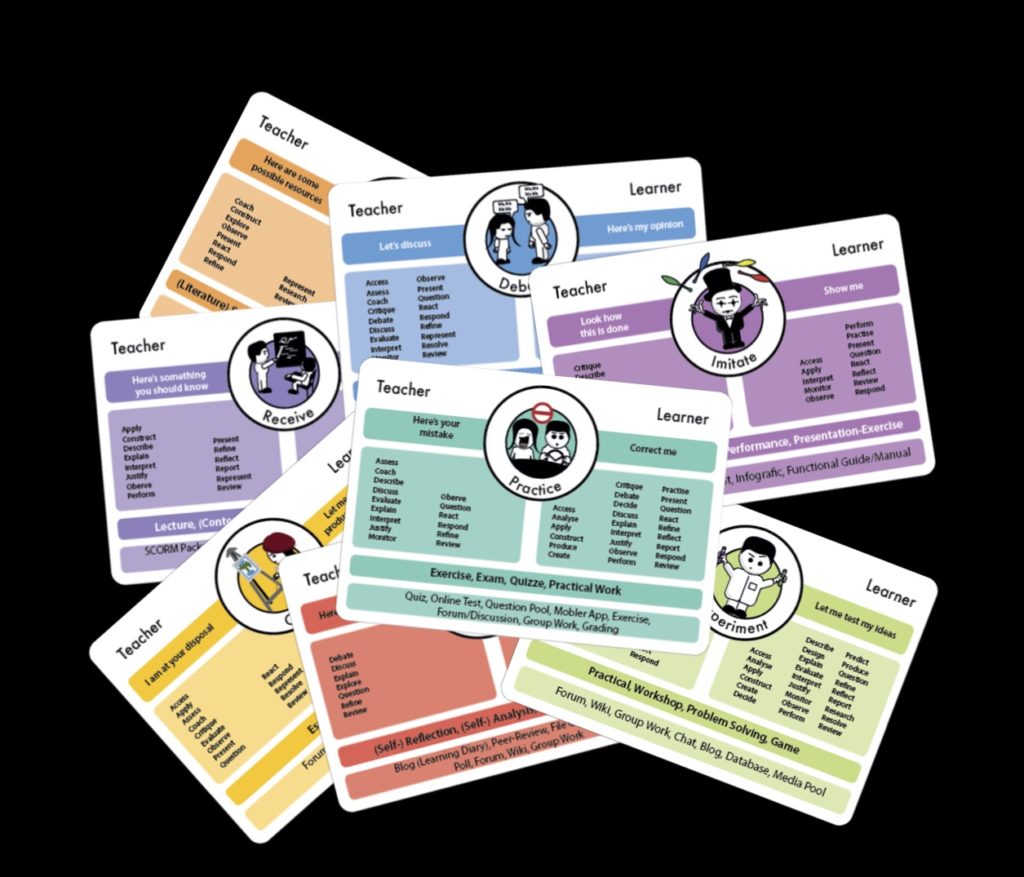
Designing learning and teaching with educational technologies is challenging in traditional higher education. In order to successfully blend lectures, it is important to structure learning processes and choose appropriate tools for the learning activities within. However, integrating technology-enhanced learning into individual teaching practices is very often constrained by limited time for rethinking course designs and teaching concepts. Therefore, support is needed for selecting and integrating appropriate technologies into teaching concepts, efficiently. As most teachers are drawing on an existing face-to-face teaching practice, such support needs to consider these transitions as part of transforming conventional teaching to technology-enhanced learning and reverse. The Learning Design Cards (see picture) are a pattern-based approach for preparing and analysing complex learning and teaching that allows professors and lecturers to build their teaching concepts on top of tested didactics. The solution provides a toolkit and a framework that helps to conceptualise, analyse, and communicate learning designs of different scales and speed-up the deployment of richer learning experiences using off-the-shelf LMS functions and features.
Pattern-based Framework for Learning Design
The Learning Design framework focuses on the integration of fundamental and aggregate educational design patterns and addresses the concepts of a pattern language for meaningful and more consistent course designs with some or full technological support (Kelle, 2012; Koper, 2003). It builds on an extended version of the Hybrid Learning Model (Masson, MacNeill, Murphy, & Ross, 2008) that combines the revised Bloom’s Taxonomy (Anderson & Krathwohl, 2001) and the Eight Learning Events Model (Leclerq & Poumay, 2005) on top of Functional Aspects of Activities (Engeström, 2015). The Hybrid Learning Model focuses on the fundamental design patterns for the effectiveness of educational activities, which shares many similarities with the newer ABC-Model (Young & Perovic, 2016). Our revised model extends this approach by aligning LMS, social media and mobile tools to the different activity patterns. The new hybrid learning model has been reported independently to effectively support educators to express their educational concepts as arrangements of the model’s activity patterns.
Previous tooling focused on activity arrangements based on the personal preferences of the teachers and trainers without actively considering the design principles for arranging learning activities (Reigeluth & Carr-Chellman, 2009). Models such as the 4C/ID Model (Van Merriënboer & Kirschner, 2007) or the Conversional Model (Laurillard, 2012) identify learning design principles for arranging individual activities into designs for complex learning but provide little information on the design of concrete teaching practices, such as inverted classroom, project-based learning, case-based teaching, or inquiry-based learning (Protopsaltis et al., 2014). Efficient support for integrating technologies into teaching and learning needs to be able to break down such practices into separate activities in order to quickly select appropriate tooling.
In order to ease the design of complex learning, we connected complex design patterns found in the literature with the activity patterns of the hybrid learning model. This resulted in visual guides that support teachers and trainers in utilizing proven approaches for arranging the individual activities of their concepts. By starting from the general approach for arranging activities, educators can easily express their didactics and can select the tooling for online or mobile phases that suits each learning activity.
Toolkit and approach have been developed and tested at HTW Chur and the Faculty of Arts and Social Sciences at the University Zurich from Christian Glahn and Marion R. Gruber. The LD-Cards are licensed under CC BY-ND.
Contact
Mag. Dr. Marion R. Gruber, University of Zurich, Faculty of Arts and Social Sciences, Dean’s Office, Digital Education and Research (DLF)
Dr. Christian Glahn, Mobinaut.io
Resources
Introduction to the Learning Design Cards
Learning Design Cards (German)
Learning Design Cards (English)
Learning Design Cards (French)
Learning Design Cards (Italian) coming soon
Learning Design Cards (Dutch) coming soon
Learning Design Cards Video (German)
Presentation on OEB (English), SlideShare
References
Anderson, L. W., Krathwohl, D. R., Airasian, P. W., Cruikshank, K. A., Mayer, R. E., Pintrich, P. R., Raths, J., & Wittrock, M. C. (Ed.) (2001). A taxonomy for learning, teaching, and assessing: A revision of Bloom’s Taxonomy of Educational Objectives. New York: Longman.
Engeström, Y. (2015). Learning by expanding: an activity-theoretical approach to developmental research(Second Edition). New York: Cambridge University Press.
Kelle, S. (2012). Game Design Patterns for Learning. Aachen: Shaker Verlag.
Koper, R. (2003). Combining re-usable learning resources and services to pedagogical purposeful units of learning. In A. Littlejohn (Ed.), Reusing Online Resources: A Sustainable Approach to eLearning(pp. 46-59). London: Kogan Page.
Laurillard, D. (2012). Teaching as a Design Science. Building Pedagogical Patterns for Learning and Technology. New York and London: Routledge.
Leclercq, D., & Poumay, M. (2005). The 8 Learning Events Model and its Principles. Liege, Blegium: University of Liege. http://www.labset.net/media/prod/8LEM.pdf
Masson, A., MacNeill, A., Murphy, C., & Ross, V. (2008). The Hybrid Learning Model – A Framework for Teaching and Learning Practice. iJET – Volume 3, Special Issue 1, July 2008: TENCompetence Open Workshop in Madrid 2008, pp. 12-17.
Merriënboer, J. J. G. van, & Kirschner, P. A. (2013). Ten steps to complex learning: A systematic approach to four-component Instructional Design(Second edition). New York: Routledge.
Protopsaltis, A., Seitlinger, P., Chaimala, F., Firssova, O., Hetzner, S., Kikis- Papadakis, K., & Boytchev, P. (2014). Working environment with social and personal open tools for inquiry based learning: Pedagogic and diagnostic frameworks. The Int. Journal of Science, Mathematics and Technology Learning, 20(4), 51-63.
Reigeluth, C. M. & Carr-Chellman, A. A. (2009). Situational Principles of Instruction. In C. Reigeluth & A. A. Carr-Chellman (Eds.), Instructional-Design Theories and Models: Building a Common Knowledge Base, Vol. III(pp. 57-72). New York: Routledge.
Young, C., & Perovic, N. (2016). Rapid and Creative Course Design: As Easy as ABC? Procedia – Social and Behavioral Sciences, 228, 390-395. https://doi.org/10.1016/j.sbspro.2016.07.058
